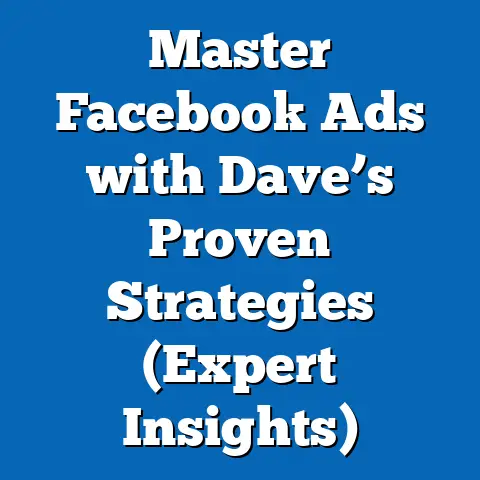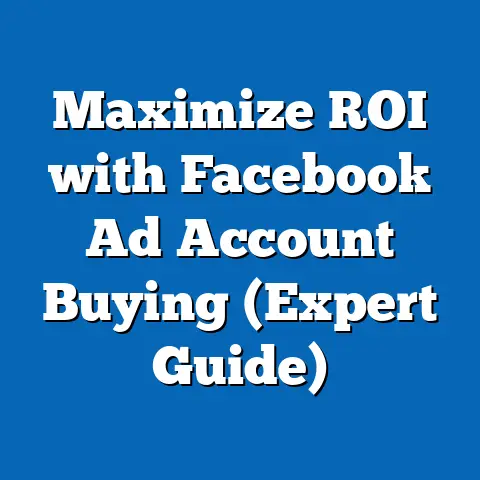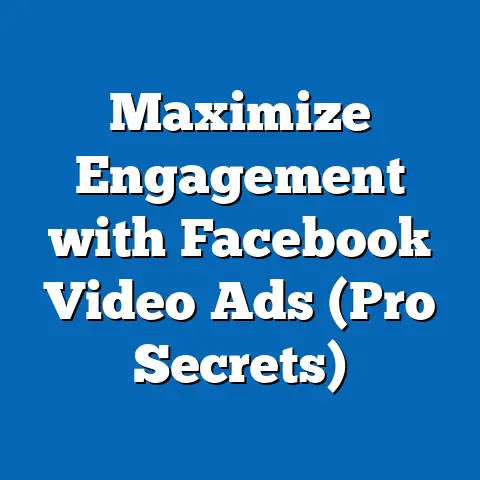Unlock Samsung’s fb ad Secrets (Proven Strategies Revealed)
Unlock Samsung’s Facebook Ad Secrets: Proven Strategies Revealed
Have you ever wondered how some companies consistently achieve remarkable results with their Facebook ad campaigns, while others struggle to gain traction? The truth is, success in Facebook advertising isn’t just about luck; it’s about understanding the platform, knowing your audience, and implementing proven strategies. Think of Samsung, a name synonymous with innovation and cutting-edge technology. Their Facebook ad campaigns aren’t just visually appealing; they’re strategically crafted to resonate with their target audience and drive meaningful results.
I’ve spent years analyzing successful Facebook ad campaigns, and I’ve noticed that companies like Samsung often employ a set of “best-kept secrets” that give them a competitive edge. These aren’t necessarily top-secret tactics hidden away in a vault, but rather a combination of best practices, data-driven insights, and a deep understanding of the Facebook advertising ecosystem.
The Importance of Facebook Advertising for Brands
Facebook, with its billions of active users, remains a powerhouse in the digital advertising landscape. It’s not just a social network; it’s a massive marketplace where brands can connect with their target audience on a personal level. For brands like Samsung, Facebook advertising is an essential tool for reaching a global audience, building brand awareness, and driving sales.
Facebook: A Marketing Platform Powerhouse
Facebook boasts an impressive array of user demographics and engagement statistics. As of recent data, Facebook has nearly 3 billion monthly active users. This sheer volume of users makes it an unparalleled platform for reaching a diverse audience.
Think about it: your potential customers are already spending time on Facebook, scrolling through their feeds, engaging with content, and connecting with friends and family. By strategically placing your ads in their feeds, you can capture their attention and introduce them to your brand.
Moreover, Facebook’s sophisticated targeting capabilities allow you to narrow down your audience based on demographics, interests, behaviors, and even custom audiences. This means you can ensure your ads are seen by the people most likely to be interested in your products or services.
The Competitive Landscape of Digital Advertising
In today’s digital age, the competition for attention is fierce. Companies are vying for eyeballs across multiple platforms, from search engines to social media networks. To stand out from the crowd, brands need to adopt innovative and effective advertising strategies.
This is where companies like Samsung excel. They understand that simply throwing money at ads isn’t enough. They invest in crafting compelling ad content, targeting the right audience, and continuously optimizing their campaigns based on data and analytics.
I’ve seen firsthand how companies that prioritize strategic planning and data-driven decision-making consistently outperform their competitors in the digital advertising arena. It’s not about having the biggest budget; it’s about using your budget wisely and maximizing your return on investment.
Benefits of Facebook Ads for Businesses of All Sizes
One of the greatest advantages of Facebook advertising is its accessibility to businesses of all sizes. Whether you’re a small startup or a multinational corporation, Facebook ads can be a cost-effective way to reach your target audience and achieve your marketing goals.
Here are some of the key benefits of Facebook ads:
- Targeting Capabilities: As I mentioned earlier, Facebook’s targeting capabilities are incredibly powerful. You can target your ads based on a wide range of factors, including age, gender, location, interests, behaviors, and even custom audiences based on your existing customer data.
- Cost-Effectiveness: Compared to traditional advertising methods, Facebook ads can be much more cost-effective. You have control over your budget and can set daily or lifetime spending limits. Plus, you only pay when people take action, such as clicking on your ad or watching your video.
- Measurable Results: Facebook provides detailed analytics that allow you to track the performance of your ad campaigns. You can see how many people are seeing your ads, how many are clicking on them, and how many are converting into customers. This data allows you to continuously optimize your campaigns and improve your ROI.
- Brand Awareness: Even if people don’t immediately click on your ad or make a purchase, Facebook ads can help you build brand awareness. By consistently showing your ads to your target audience, you can increase their familiarity with your brand and make them more likely to consider your products or services in the future.
- Flexibility: Facebook offers a variety of ad formats, including image ads, video ads, carousel ads, and collection ads. This allows you to choose the format that best suits your message and target audience.
Takeaway: Facebook advertising is a powerful tool for businesses of all sizes. By understanding the platform, targeting the right audience, and creating compelling ad content, you can achieve remarkable results and grow your business.
Understanding Samsung’s Target Audience
One of the key factors behind Samsung’s success in Facebook advertising is their deep understanding of their target audience. They don’t just create generic ads and hope for the best; they carefully define their audience, segment them based on various factors, and tailor their ads to resonate with each segment.
Defining and Targeting the Audience
Samsung’s target audience is vast and diverse, encompassing a wide range of demographics, interests, and behaviors. To effectively reach this audience, Samsung employs a sophisticated approach to targeting.
First, they define their core audience based on factors such as age, gender, location, income, and education. Then, they segment this audience based on interests, such as technology, gaming, photography, and fitness.
For example, they might target tech enthusiasts with ads showcasing the latest features of their smartphones, while targeting photography enthusiasts with ads highlighting the camera capabilities of their devices.
Customer Personas and Segmentation Strategies
To further refine their targeting, Samsung creates detailed customer personas that represent different segments of their audience. These personas are fictional characters that embody the characteristics, motivations, and pain points of a specific customer segment.
For example, they might create a persona called “Tech-Savvy Tom,” who is a young, tech-savvy professional who is always on the lookout for the latest gadgets. Or they might create a persona called “Photography Enthusiast Sarah,” who is a passionate photographer who values high-quality camera equipment.
By creating these personas, Samsung can gain a deeper understanding of their audience and tailor their ads to resonate with each persona’s specific needs and interests.
Examples of Targeted Campaigns
I’ve seen numerous examples of Samsung’s campaigns that targeted specific demographics and interests. For instance, when launching a new gaming phone, they might target gamers on Facebook with ads showcasing the phone’s powerful processor, high refresh rate display, and advanced cooling system.
These ads would likely feature gameplay footage, testimonials from professional gamers, and calls to action that encourage viewers to learn more about the phone and pre-order it.
On the other hand, when promoting a new smartwatch, they might target fitness enthusiasts with ads highlighting the watch’s health tracking features, such as heart rate monitoring, sleep tracking, and activity tracking.
These ads would likely feature images of people using the watch while exercising, testimonials from fitness experts, and calls to action that encourage viewers to learn more about the watch and purchase it.
Takeaway: Understanding your target audience is crucial for success in Facebook advertising. By defining your audience, segmenting them based on various factors, and creating detailed customer personas, you can tailor your ads to resonate with each segment’s specific needs and interests.
Crafting Compelling Ad Content
Even with the most sophisticated targeting strategies, your ads won’t be effective if the content isn’t compelling. Samsung understands this, and they invest heavily in creating ad content that captures attention, tells a story, and motivates viewers to take action.
Elements of Compelling Ad Content
There are several key elements that contribute to compelling ad content:
- Storytelling: People are naturally drawn to stories. Samsung often uses storytelling in their ads to connect with viewers on an emotional level. They might tell the story of how their products have helped people achieve their goals, overcome challenges, or improve their lives.
- Visuals: High-quality visuals are essential for capturing attention on Facebook. Samsung uses stunning images and videos that showcase their products in the best possible light. They also use visuals to convey emotions and tell stories.
- Calls to Action: A clear and compelling call to action is crucial for motivating viewers to take the next step. Samsung uses calls to action that are specific, relevant, and action-oriented. For example, “Learn More,” “Shop Now,” or “Pre-Order Today.”
Successful Ad Formats Used by Samsung
Samsung leverages a variety of ad formats on Facebook, including:
- Video Ads: Video ads are highly engaging and allow Samsung to showcase their products in action. They often use video ads to highlight the features and benefits of their products, tell stories, and create emotional connections with viewers.
- Carousel Ads: Carousel ads allow Samsung to showcase multiple products or features in a single ad. This is a great way to highlight the versatility of their product line and give viewers a range of options to choose from.
- Collection Ads: Collection ads are a visually appealing format that allows Samsung to showcase their products in a catalog-like format. This is a great way to drive traffic to their website and encourage viewers to browse their product line.
Analyzing Specific Ads from Samsung
I’ve analyzed numerous Samsung ads that have resonated well with their audience. One example is a video ad for their Galaxy S21 smartphone that features stunning footage of people using the phone in various settings, such as taking photos, playing games, and watching videos.
The ad also features testimonials from satisfied customers who rave about the phone’s features and performance. The call to action encourages viewers to “Learn More” about the phone and pre-order it.
What makes this ad so effective is its combination of stunning visuals, compelling storytelling, and clear call to action. It captures attention, creates an emotional connection with viewers, and motivates them to take the next step.
Takeaway: Compelling ad content is essential for success in Facebook advertising. By focusing on storytelling, visuals, and calls to action, you can create ads that capture attention, resonate with your audience, and drive meaningful results.
Leveraging Facebook Ad Features and Tools
Facebook Ads Manager is a powerful platform that offers a wide range of features and tools to help you optimize your ad campaigns. Samsung leverages these features and tools to fine-tune their targeting, improve their ad creative, and track their results.
A/B Testing
A/B testing is a crucial tool for optimizing your ad campaigns. It allows you to test different versions of your ads to see which ones perform best. Samsung uses A/B testing to experiment with different headlines, images, videos, and calls to action.
For example, they might test two different versions of a video ad, one with a shorter headline and one with a longer headline. By tracking the performance of each version, they can determine which headline resonates best with their audience and use that headline in future ads.
Tracking Conversions
Tracking conversions is essential for measuring the ROI of your ad campaigns. It allows you to see how many people who click on your ads are actually converting into customers. Samsung uses Facebook Pixel to track conversions on their website.
Facebook Pixel is a small piece of code that you can install on your website. It tracks the actions that people take on your website after clicking on your ad, such as adding items to their cart, completing a purchase, or filling out a form.
By tracking conversions, Samsung can see which ad campaigns are driving the most sales and focus their efforts on those campaigns.
Retargeting
Retargeting is a powerful technique that allows you to show ads to people who have previously interacted with your brand. For example, you can retarget people who have visited your website, watched your videos, or engaged with your Facebook page.
Samsung uses retargeting to re-engage people who have shown an interest in their products but haven’t yet made a purchase. They might show these people ads featuring special offers, discounts, or testimonials from satisfied customers.
Adapting Strategies Based on Data and Analytics
The beauty of Facebook advertising is that it’s data-driven. You can track the performance of your ad campaigns in real-time and make adjustments based on the data. Samsung uses Facebook Analytics to track the performance of their ad campaigns and identify areas for improvement.
For example, if they notice that one of their ad campaigns is performing poorly, they might adjust their targeting, ad creative, or bidding strategy. By continuously monitoring their results and adapting their strategies, they can ensure that their ad campaigns are always performing at their best.
Takeaway: Facebook Ads Manager offers a wide range of features and tools to help you optimize your ad campaigns. By leveraging these features and tools, you can fine-tune your targeting, improve your ad creative, and track your results.
Budgeting and Bidding Strategies
Budgeting and bidding are critical aspects of Facebook advertising. It’s essential to set a budget that aligns with your marketing goals and choose a bidding strategy that maximizes your ROI.
Daily vs. Lifetime Budgets
Facebook offers two main types of budgets: daily budgets and lifetime budgets. A daily budget allows you to set a specific amount of money that you’re willing to spend each day on your ad campaign. A lifetime budget allows you to set a total amount of money that you’re willing to spend over the entire duration of your ad campaign.
Samsung uses both daily and lifetime budgets, depending on the specific goals of their ad campaigns. For example, they might use a daily budget for campaigns that are designed to generate leads or drive website traffic. They might use a lifetime budget for campaigns that are designed to build brand awareness or promote a specific product launch.
Bidding Strategies
Facebook offers a variety of bidding strategies, including:
- Lowest Cost: This bidding strategy aims to get you the most results for your budget. Facebook will automatically adjust your bids to get you the lowest possible cost per result.
- Cost Cap: This bidding strategy allows you to set a target cost per result. Facebook will try to get you results at or below your target cost.
- Target Cost: This bidding strategy is similar to cost cap, but it’s designed to be more stable. Facebook will try to get you results as close to your target cost as possible.
- Bid Cap: This bidding strategy allows you to set a maximum bid that you’re willing to pay for each result. Facebook will never bid higher than your maximum bid.
Samsung uses a variety of bidding strategies, depending on the specific goals of their ad campaigns. For example, they might use the lowest cost bidding strategy for campaigns that are designed to generate leads or drive website traffic. They might use the cost cap bidding strategy for campaigns that are designed to promote a specific product launch and they have a good understanding of what a conversion is worth.
Adjusting Budget Allocation Based on Campaign Performance and Seasonal Trends
Samsung continuously monitors the performance of their ad campaigns and adjusts their budget allocation accordingly. If they notice that one of their ad campaigns is performing particularly well, they might increase the budget for that campaign to maximize its impact.
They also adjust their budget allocation based on seasonal trends. For example, they might increase their advertising budget during the holiday season to take advantage of increased consumer spending.
Takeaway: Budgeting and bidding are critical aspects of Facebook advertising. By setting a budget that aligns with your marketing goals and choosing a bidding strategy that maximizes your ROI, you can ensure that your ad campaigns are successful.
Measuring Success and Optimizing Campaigns
Measuring the success of your Facebook ad campaigns is essential for determining whether your efforts are paying off. It also provides valuable insights that you can use to optimize your campaigns and improve your ROI.
Key Performance Indicators (KPIs)
There are several key performance indicators (KPIs) that Samsung tracks to measure the success of their Facebook ad campaigns, including:
- Reach: The number of people who have seen your ad.
- Impressions: The number of times your ad has been displayed.
- Clicks: The number of times people have clicked on your ad.
- Click-Through Rate (CTR): The percentage of people who have seen your ad and clicked on it.
- Conversions: The number of people who have taken a desired action after clicking on your ad, such as making a purchase or filling out a form.
- Cost Per Conversion: The amount of money you’ve spent to generate one conversion.
- Return on Ad Spend (ROAS): The amount of revenue you’ve generated for every dollar you’ve spent on advertising.
Continuous Optimization
Facebook advertising is an ongoing process. It’s not enough to simply set up your ad campaigns and forget about them. You need to continuously monitor their performance and make adjustments based on the data.
Samsung continuously optimizes their ad campaigns based on real-time feedback. If they notice that one of their ad campaigns is performing poorly, they might adjust their targeting, ad creative, or bidding strategy.
Case Studies of Mid-Flight Adjustments
I’ve seen numerous examples of Samsung campaigns that were adjusted mid-flight for better performance. For instance, in one case, they noticed that their ad campaign was generating a lot of clicks but not many conversions.
After analyzing the data, they realized that their landing page was not optimized for conversions. They made some changes to their landing page, such as adding a clearer call to action and simplifying the checkout process.
As a result of these changes, their conversion rate increased significantly, and their ROI improved dramatically.
Takeaway: Measuring the success of your Facebook ad campaigns is essential for determining whether your efforts are paying off. By tracking key performance indicators and continuously optimizing your campaigns, you can improve your ROI and achieve your marketing goals.
Conclusion
Unlocking the secrets to Samsung’s success in Facebook advertising isn’t about discovering hidden tricks or magic formulas. It’s about understanding the fundamentals of the platform, knowing your audience, crafting compelling ad content, leveraging Facebook’s features and tools, and continuously measuring and optimizing your campaigns.
These “best-kept secrets” are accessible to any business willing to put in the effort to learn and adapt. By implementing the proven strategies outlined in this guide, you can unlock your own potential for success in Facebook advertising, just like Samsung has done.
I encourage you to take what you’ve learned here and apply it to your own Facebook advertising efforts. Experiment with different targeting strategies, ad formats, and bidding strategies. Track your results, analyze your data, and continuously optimize your campaigns.
With dedication, perseverance, and a willingness to learn, you can achieve remarkable results and grow your business with Facebook advertising. Now go out there and make it happen!






